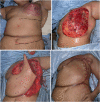Thoracoabdominal Flap: a Simple Flap for Covering Large Post-mastectomy Soft Tissue Defects in Locally Advanced Breast Cancer
- PMID: 31496598
- PMCID: PMC6707995
- DOI: 10.1007/s13193-019-00927-4
Thoracoabdominal Flap: a Simple Flap for Covering Large Post-mastectomy Soft Tissue Defects in Locally Advanced Breast Cancer
Abstract
Locally advanced breast cancer (LABC) constitutes 40-50% of breast cancer in developing countries. Large soft tissue defects after mastectomy often require some additional cover. The primary aim of reconstruction in this group should be an expeditious and simple closure with good-quality skin cover, early recovery, and short hospital stay so that the patients can receive early post-operative radio-chemotherapy. Thoracoabdominal (TA) flap is a type-c fasciocutaneous flap and the skin and fat of the upper abdomen are used, based on medial or lateral perforating vessels. We present our experience of TA flap cover for large post-mastectomy defects. A retrospective analysis of prospectively maintained breast cancer database in the Department of Surgical Oncology from January 1994 to December 2017 at All India Institute of Medical Sciences, New Delhi, was performed. The medical records of patients undergoing TA flap cover were analyzed to assess operative duration, blood loss, post-operative morbidity, hospital stay, adjuvant treatment, recurrence patterns, and survival outcome. A total of 3142 breast cancer patients underwent surgery, of which 1840 were LABC and 88 patients (4.13%) of LABC required flap cover for the closure of mastectomy defect. TA flap was used in majority of these patients 72/83 (86.7%) for cover. Majority was stage IIIB (54 out of 72) and we could achieveR0 resection in all patients. TA flap was done following MRM in 60 patients and RM in 12 patients. Upfront primary surgery was performed in 27 patients and 45 underwent surgery after neoadjuvant chemotherapy. Most commonly laterally based flaps were done, except 4 medially based flaps. The mean operating time was 30 min and blood loss was 45 ml. Mean hospital stay was 4.45 days. Superficial flap necrosis occurred in 6 and wound infection in 4 patients, all managed conservatively. Only 2 patients had major flap loss and required debridement and skin grafting. Planned post-operative radiation could be delivered in most of the patients in time. At a mean follow-up of 24 months, only 9 out of 72 (12.5%) patients had a loco-regional recurrence. Results of our experience show that TA flap is a simple, cost-effective procedure for managing large post-mastectomy soft tissue defects in LABC. It has huge potential in developing countries dealing with a large number of LABC because of simplicity and short learning curve.
Keywords: Locally advanced breast cancer; Post-mastectomy defects; Thoracoabdominal flap (TA flap).
Figures
Similar articles
-
Medially Based "Abdominal Rotation Advancement Flap": A Promising Technique for Mastectomy Defect Reconstruction in "High-Risk Patients" Awaiting Adjuvant Radiotherapy.Indian J Plast Surg. 2024 Sep 3;57(Suppl 1):S73-S79. doi: 10.1055/s-0044-1788571. eCollection 2024 Dec. Indian J Plast Surg. 2024. PMID: 39741731 Free PMC article.
-
Myocutaneous versus thoraco-abdominal flap cover for soft tissue defects following surgery for locally advanced and recurrent breast cancer.J Surg Oncol. 2003 May;83(1):31-5. doi: 10.1002/jso.10236. J Surg Oncol. 2003. PMID: 12722094
-
Short Stay Management of Locally Advanced Breast Cancer Using Immediate Local Thoracoabdominal Advancement Flap and Enhanced Recovery After Surgery Protocol.Ann Plast Surg. 2022 May 1;88(4 Suppl 4):S366-S373. doi: 10.1097/SAP.0000000000003140. Ann Plast Surg. 2022. PMID: 37740470
-
New treatment sequence protocol to reconstruct locally advanced breast cancer.ANZ J Surg. 2013 Sep;83(9):630-5. doi: 10.1111/ans.12110. Epub 2013 Mar 15. ANZ J Surg. 2013. PMID: 23496238 Review.
-
Neoadjuvant radiotherapy for locally advanced and high-risk breast cancer.J Med Imaging Radiat Oncol. 2021 Jun;65(3):345-353. doi: 10.1111/1754-9485.13180. Epub 2021 Apr 5. J Med Imaging Radiat Oncol. 2021. PMID: 33821576 Review.
Cited by
-
Assessment of Chemotherapy Knowledge and Practices Among Breast Surgeons in India: Identifying Gaps and Areas for Improvement.Indian J Surg Oncol. 2025 Feb;16(1):103-108. doi: 10.1007/s13193-024-02040-7. Epub 2024 Jul 30. Indian J Surg Oncol. 2025. PMID: 40114872
References
-
- Leinster SJ, Webster JT. Thoracoabdominal and thoracoepigastric flaps: alternatives to skin grafting after mastectomy. Clin Oncol. 1992;8:145–148. - PubMed
-
- Lee SH, Cheah DS, Krishnan MM. Omental transposition flap and split skin graft for locally advanced breast carcinoma. Singap Med J. 1990;31:217–220. - PubMed
-
- Jhulka PK, Prasad R, Mohanti BK, et al. Cancer of the breast. In: Rath GK, Mohanti BK, et al., editors. Textbook of radiation oncology. New Delhi: B. I. Churchill Livingstone; 2000. pp. 239–284.
LinkOut - more resources
Full Text Sources



